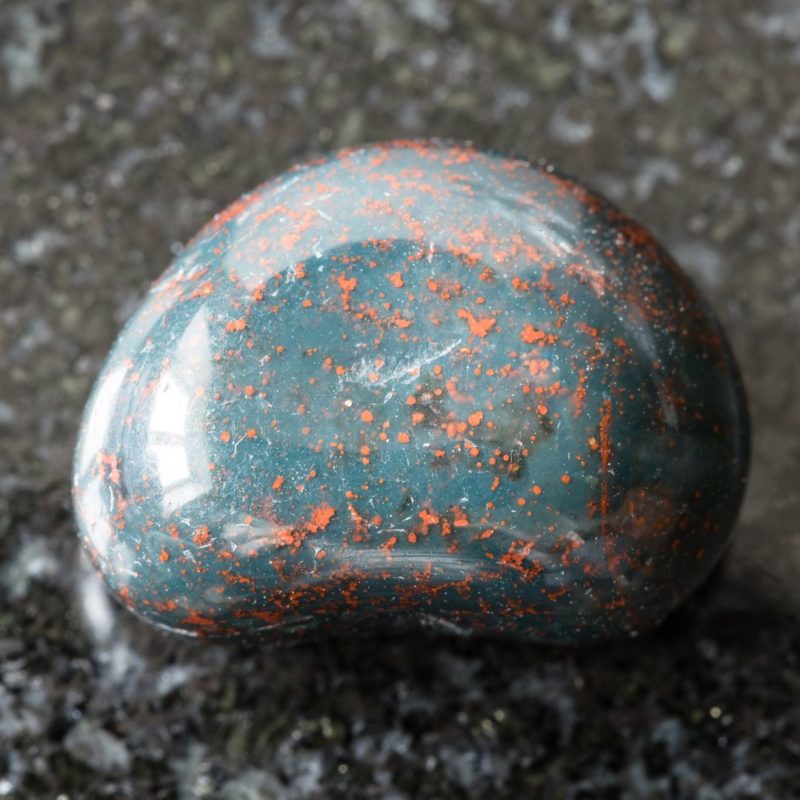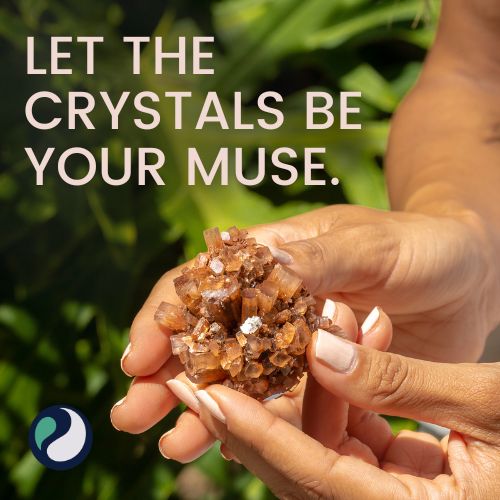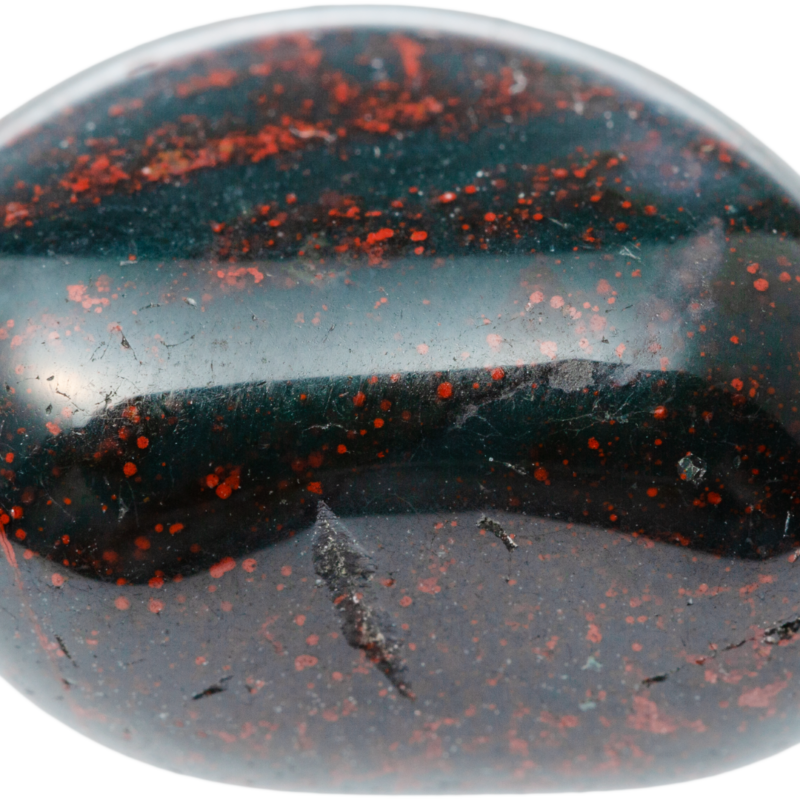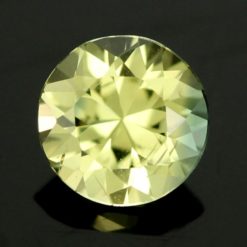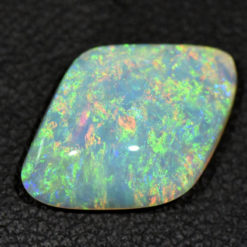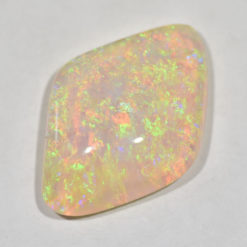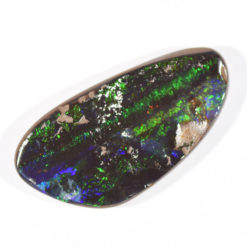No products in the cart.
Gemstone Information
Heliotrope Stone – Definition, Uses and Appearance
The Heliotrope Stone, commonly known as Bloodstone, carries a rich tapestry of history, mystique, and utility that spans across centuries and cultures. This captivating gemstone is not only renowned for its unique appearance, marked by its deep green color with distinctive red spots resembling drops of blood, but also for its versatile uses and supposed healing properties. The essence of Heliotrope lies in its mineral composition, a member of the Chalcedony family, embedded with iron oxide inclusions that gift it its blood-like embellishments.
Historically revered and sought after for its metaphysical attributes and ornamental value, Heliotrope Stone has found its place in various settings from ancient jewelry and amulets to modern decorative items and holistic healing practices. Its appearance, symbolic of vitality and endurance, coupled with its alleged healing prowess, makes it a stone of both beauty and purpose.
As we delve into the world of Heliotrope Stone, we will explore its definition, the myriad of uses it offers, and the unique appearance that has made it a subject of admiration and intrigue through the ages. Join us on this journey to uncover the allure and the practical applications of this remarkable gemstone.
Definition of Heliotrope Stone
The Heliotrope Stone, enchantingly referred to as Bloodstone, is a captivating gem that boasts a striking appearance and intriguing composition. A member of the Chalcedony family, this stone is primarily characterized by its deep green base, which serves as a canvas for splatters of red, creating a visual reminiscent of drops of blood. These distinctive red spots owe their vibrant hue to the presence of iron oxides, particularly hematite, which intricately weaves through the stone’s structure.
Heliotrope belongs to the quartz group, a testament to its durability and luster, making it an ideal candidate for various ornamental and functional uses. Its composition includes a cryptocrystalline quartz, which is a type of silica mineral characterized by its microscopic crystal structure. This fine-grained structure not only contributes to the stone’s aesthetic appeal but also to its tactile qualities, making it a favored material in the crafting of jewelry and decorative items.
The name “Heliotrope” itself is steeped in history and etymology, deriving from the Greek words ‘helios’ meaning sun, and ‘trepein’ meaning to turn. This name is believed to reflect the ancient use of the stone in solar rituals or its association with the reflection of sunlight. Throughout history, Heliotrope Stone has been enveloped in a veil of mysticism and lore, often associated with protection, health, and longevity.
Historical Significance
The historical significance of the Heliotrope Stone, or Bloodstone, is as rich and variegated as its appearance. This gemstone’s journey through time encapsulates its revered status across various civilizations, serving both as a symbol of vitality and an object of beauty. The allure of Heliotrope transcends mere aesthetics, embedding itself within the lore and rituals of ancient societies.
In ancient times, Heliotrope Stone was believed to possess powerful protective and healing properties. Warriors and athletes in Greek and Roman cultures often carried Bloodstone amulets or wore them as jewelry to enhance their endurance and protect them during battle or competitions. This belief in the stone’s protective virtues is partly attributed to its appearance, where the red spots were thought to symbolize the blood of Christ in Christian traditions, offering healing and protection.
Beyond its purported metaphysical attributes, Heliotrope also held a place of honor in medieval texts and alchemy. Renowned for its ability to staunch wounds and purify blood, it was a stone closely associated with health and healing. Alchemists and herbalists prized it, incorporating the gem into their practices and lore, further cementing its place in the annals of history as a stone of great power and mystery.
The Heliotrope Stone’s historical significance is not limited to its mystical and medicinal uses. It was also a favored material in the creation of seals, signets, and decorative objects, prized for its durability and the finesse with which it could be carved. The Renaissance period saw an increased use of Bloodstone in the arts, with craftsmen creating intricate cameos and intaglios that highlighted its natural beauty and coloration.
Physical Appearance
The physical appearance of Heliotrope Stone is both distinctive and mesmerizing, setting it apart from other gemstones with its unique coloration and patterning. At its core, Heliotrope, or Bloodstone, is characterized by its deep green color, which can range from a dark, almost black green, to a lighter, more translucent hue. This verdant backdrop is punctuated by vivid spots or flecks of red, which are its defining feature. These red markings, reminiscent of drops of blood, owe their color to iron oxide inclusions, primarily hematite, that are interspersed throughout the stone.
The contrast between the green chalcedony and the red spots is what gives Heliotrope its striking appearance and its name—Bloodstone. The intensity and distribution of these red spots can vary significantly from one stone to another, making each piece uniquely beautiful. In some specimens, the red inclusions are sparse and delicate, while in others, they can be so abundant that they cover much of the stone’s surface.
The texture of Heliotrope Stone further contributes to its appeal. As a type of quartz, it possesses a smooth, glassy luster when polished, making it a popular choice for jewelry and decorative items. The stone can be cut and shaped into various forms, from rounded cabochons that highlight its natural patterns to intricate carvings that showcase its color contrast.
Beyond its visual allure, the physical properties of Heliotrope also speak to its durability and utility. It ranks at about 6.5 to 7 on the Mohs scale of hardness, making it sufficiently hard to be fashioned into wearable items that can withstand the rigors of daily use without easily scratching or chipping.
Healing Properties and Metaphysical Beliefs
The allure of the Heliotrope Stone transcends its physical beauty, extending into the realm of healing properties and metaphysical beliefs that have been associated with it for centuries. This gemstone, also known as Bloodstone, is reputed to be a powerful healing crystal, imbued with the energy to cleanse and invigorate the body and spirit.
Heliotrope Stone Healing Properties:
Among the most celebrated of Heliotrope’s healing attributes is its purported ability to purify the blood and enhance circulation. This belief stems from the stone’s vivid red inclusions, symbolically linked to vitality and life force. Practitioners of crystal healing value Heliotrope for its potential to boost the immune system, stimulate energy flow, and enhance the resilience of the physical body. It is also thought to have detoxifying properties, helping to eliminate toxins and cleanse the organs.
Beyond its physical healing virtues, Heliotrope is believed to possess emotional and psychological benefits. It is said to ground and protect, imbuing the wearer or bearer with courage, self-esteem, and determination. Its calming influence is thought to dispel confusion and enhance decision-making, making it a valued stone in times of stress or upheaval.
Metaphysical Beliefs:
Heliotrope Stone is deeply rooted in metaphysical lore, where it holds a place of significance in spiritual and energy work. It is associated with the root chakra, believed to enhance one’s connection to the earth and provide grounding energy. This connection fosters a sense of security and stability, empowering individuals to face life’s challenges with confidence and resilience.
The stone is also celebrated for its ability to foster creativity, enhance intuition, and promote spiritual growth. It encourages selflessness and idealism, aiding those who seek to align their actions with their higher purpose. In meditation and spiritual practices, Heliotrope is used as a tool for focusing intent and amplifying energy, particularly in endeavors related to healing and protection.
Uses of Heliotrope Stone
The Heliotrope Stone, with its unique blend of beauty, historical significance, and metaphysical attributes, has been cherished across cultures for its versatility and utility. Known also as Bloodstone, its applications range from ornamental and decorative to spiritual and healing, showcasing its multifaceted value in various aspects of life.
Jewelry and Ornamentation:
One of the most common uses of Heliotrope is in jewelry making. Its striking appearance, characterized by a deep green color punctuated with red spots, makes it a popular choice for rings, pendants, bracelets, and earrings. Artisans value the stone for its ability to be cut and polished into various shapes and sizes, allowing for creative expression in design. The durability of Heliotrope, ranking at about 6.5 to 7 on the Mohs hardness scale, also contributes to its suitability for everyday wear.
Decorative Items:
Beyond personal adornment, Heliotrope is utilized in creating decorative items such as carved figurines, bookends, and coasters. Its rich color and unique patterning add a touch of natural beauty to home decor, making it a favored material for items that combine aesthetic appeal with functionality.
Healing and Wellness:
Echoing centuries-old traditions, Heliotrope continues to be valued in the realm of crystal healing for its purported health benefits. It is used in practices aimed at purifying the blood, boosting immunity, and enhancing overall vitality. Individuals seeking emotional balance and mental clarity might also turn to Heliotrope for its grounding and protective properties. Placed in living spaces or carried as a personal talisman, the stone is believed to foster a sense of well-being and resilience.
Spiritual Practices:
The metaphysical aspects of Heliotrope make it a sought-after stone in spiritual practices. It is often used in meditation, energy work, and chakra balancing, where it is believed to enhance connection to the earth, provide grounding energy, and support spiritual growth. Practitioners may use it to focus intent, amplify energy, and foster a deeper sense of harmony and purpose.
Artistic and Historical Objects:
The historical significance of Heliotrope has made it a material of choice for artisans throughout the ages. It has been used to craft seals, amulets, and religious artifacts, each bearing the mark of the cultures and beliefs that valued it. Today, these objects continue to be appreciated not only for their beauty but for the stories and traditions they embody.
Care and Maintenance
Caring for Heliotrope Stone, with its unique composition and historical value, requires attention and respect for its natural properties. The beauty and longevity of this gemstone can be preserved through proper care and maintenance, ensuring that it continues to captivate with its deep green hues and vibrant red spots for years to come.
Cleaning:
Heliotrope should be cleaned gently to avoid scratching its surface or damaging its intricate patterns. It is advisable to use lukewarm water mixed with a mild soap. Using a soft, lint-free cloth, gently clean the stone, avoiding harsh chemicals or abrasive materials that could harm its finish. After cleaning, rinse the stone with clean water and dry it thoroughly with a soft cloth.
Storage:
To prevent scratches or other damage, store your Heliotrope Stone separately from other jewelry. It is best kept in a fabric-lined box or a soft pouch. This precaution is particularly important for pieces of jewelry where the Heliotrope is set alongside harder gemstones that might scratch its surface.
Avoiding Extreme Conditions:
Heliotrope is relatively durable, but like all gemstones, it can be susceptible to extreme temperature changes and harsh chemicals. Exposure to direct sunlight for prolonged periods should be avoided to maintain the color vibrancy of the stone. Likewise, it is advisable to remove Heliotrope jewelry before engaging in activities that might expose it to harsh chemicals, such as swimming in chlorinated water or cleaning with strong detergents.
Regular Inspection:
Regular inspection of Heliotrope jewelry, especially items like rings and bracelets that are prone to wear, is essential. Checking for loose settings or signs of wear can help prevent the loss of the stone. Professional jewelers can provide cleaning services, repair damage, and ensure that settings are secure, preserving the beauty and integrity of your Heliotrope items.

Conclusion
The Heliotrope Stone, with its rich history, captivating appearance, and myriad uses, is a gemstone that continues to fascinate and inspire. From its deep green canvas adorned with vivid red spots that resemble droplets of blood, to its associations with health, vitality, and protection, Heliotrope embodies a unique blend of beauty and mystique. This gemstone’s journey through time, from ancient civilizations to modern-day jewelers and healers, underscores its enduring appeal and versatility.
In exploring the definition, uses, and appearance of Heliotrope Stone, we have uncovered not just a gemstone, but a symbol of human fascination with the natural world. Its historical significance, rooted in lore and tradition, speaks to the deep connections people have sought with the earth and its treasures. Meanwhile, its physical attributes, from its coloration to its mineral composition, highlight the marvels of natural formation and the aesthetic pleasures they bring.
Heliotrope’s healing properties and metaphysical beliefs add another layer to its allure, offering pathways to well-being and spiritual enrichment. The uses of Heliotrope, spanning decorative, medicinal, and personal adornment, reflect its adaptability and the personal meanings it can hold. And through careful care and maintenance, we ensure that the beauty and power of Heliotrope Stone are preserved for future generations to admire and explore.
As we conclude our exploration of Heliotrope Stone, it becomes clear that this gemstone is more than just a physical object. It is a testament to the beauty and complexity of the natural world, a connector of cultures and histories, and a source of inspiration and healing. Whether admired in a museum, worn as jewelry, or used in healing practices, Heliotrope Stone invites us to marvel at the wonders of our planet and to appreciate the connections between its past, present, and future.


